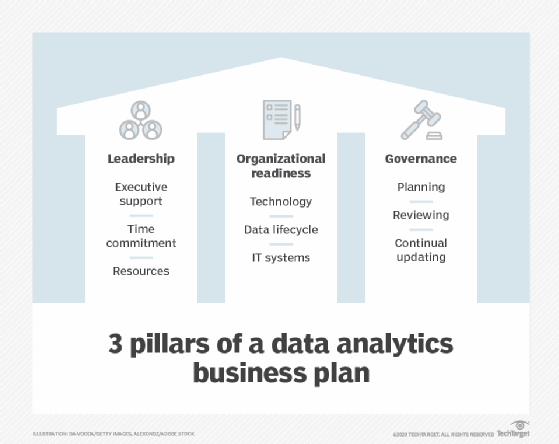
yurolaitsalbert - Fotolia
Implementing an analytics business plan requires commitment
To get the most out of a data analytics business plan, companies must have clear goals and communication, as well as proper buy-in companywide.
Approaching analytics can be daunting for companies of any size and the stakes are often high. Collecting data is one thing, but gleaning useful and actionable information out of it can be a troublesome next step.
Implementing a data analytics business plan, even with patience and broad commitment, can still prove difficult to tackle if the proper groundwork is not laid.
Companies need to be adaptive and take the right approach with data before an analytics plan can be used effectively. As with most major shifts and projects, it is the amount of focus and effort put into a data analytics business plan that can determine its success.
Laying the groundwork
An early step companies must take before deploying a business analytics plan is ensuring they have the right architecture. There must be clarity and communication, as well as a clear objective companywide.
"Clarity on what you are attempting to do means you know what your objectives are," said Ash Munshi, CEO of Pepperdata, a California-based software company. "It is invaluable for communicating within your company as goals help get teams on the same page, provide a framework for decision-making and help you measure your progress along the way."
Beginning a data analytics business plan requires the identification of where real business value can be created. From this, companies can begin to lay out realistic goals. This should also be done in concert with assessing the data that is already being collected.
Once your company has clear communication and defined goals, ensuring that you have high-quality data is the next step.
"The companies that develop robust data and analytics strategies are the ones that will succeed and excel in the data-driven world," Munshi said. "Operational data about your analytics infrastructure and applications is also critically important to ensure those systems perform optimally."
To aid in this data assessment, there should be a great deal of communication between IT departments and other groups within the business.
"IT groups should be directly and tightly connected to the business owners of the data," said Steve Tycast, director of data and analytics at AIM Consulting Minneapolis. "Connected IT teams are a critical relationship and one that is often lacking strength in many organizations today."
Pillars supporting the plan
The only way to discover the right answers is to ask the right questions. In order to further ensure that your data analytics business plan is working toward an actionable goal, your company needs to work with its employees or outside businesses to create queries and reports that can identify their business needs.
Once your needs are identified, your goals are set out and communication is improved, the data analytics business plan can be implemented.
"There are essentially three pillars to successfully implementing an analytics business plan," Tycast said. "Leadership, organizational readiness and governance."

Leadership comes down to executive sponsorship and involvement in the plan with a commitment to seeing it through. They must create a culture that accepts this plan and commit to a proper investment of time and resources.
To get the most out of their data, companies need to understand their organizational maturity from both business and technology perspectives, Tycast said. For the former, organizations need to take a critical look at their current processes and map how data is used throughout the lifecycle. For the latter, an organization needs to assess their current IT systems and applications and align their processes to that of the business.
When it comes to governance, proper planning and regular review of a data analytics plan is essential.
"Every analytics project is a journey, not a destination, and therefore requires the continual care and attention to ensure you are receiving the maximum insights and value of your data," Tycast said.
Being adaptable can be the difference between success and failure.
Foster the right skills
The demands on businesses are only growing as technology advances, and it can be intimidating to begin a journey into analytics.
For companies to get the most out of their analytics plans, their data must be their most strategic asset. Assisting with this data are the correct employees for the job. It is critically important for companies seeking to get the most out of an analytics plan to invest in developing the necessary skills in their employees in order to deliver on their investments.
"Ideally, technology and skills/training are developed together," Munshi said. "Hiring the right talent is one of the best ways to gain a competitive advantage."
To fully take advantage of a business analytics plan, an enterprise must either grow the talent from within or acquire employees with the right skills to analyze and learn from the data the company gathers.
"The rapid pace of technology change, coupled with the business need for faster results and increased flexibility, can overwhelm any organization," Tycast said. "It is critical to strike the right balance between business users and technical professionals, where often we see success with dedicated technical resources that sit within business units and can represent the business needs with IT."
With clear communication and goals, as well as commitment and proper training, a data analytics business plan can be deployed successfully. Missing any single part of this larger picture can jeopardize its success.








